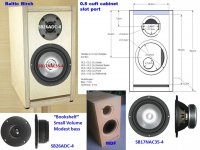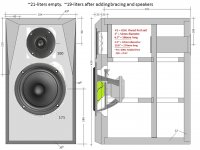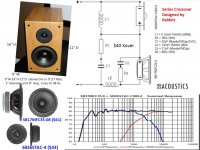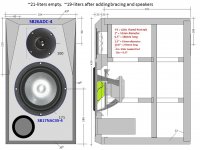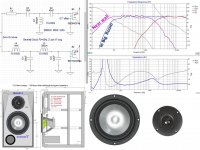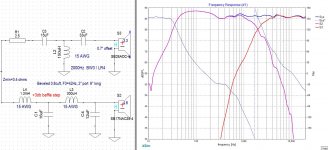Hello everyone,
I am new around here but I wish you could help me choose the best design (meaning something already tested, basically I should "only" solder the crossover, make the enclosure and put all together) to realize for my needs.
I want to make a two way bookshelf to use as main speakers for a future 5.1 system but I am gonnna use them mainly for music: Italian (old?)pop music and some classic rock.
Sadly the space for the speakers is not a lot and that's why I am going for a bookshelf design. They will also be very close to the wall so I was thinking about a closed design or a front firing bass reflex design.
My budget is about 400 euros for a pair (considering speakers and crossover material).
I don't know if I can name some online stores here but I looked up to a German one, which offers many kits designed by professionals (featured in some paper magazines), and for example the "Mona 17" popped out.
I would like to know if someone has some experience with any of the designs from this magazines also.
I mean, is there something better sounding than the mentioned design for the same price (or into my budget)?
Last but not least, I will be driving them with some class D amplification (still choosing between ICE Power or UcD boards or maybe custom designs and going for PA amps) and in the mean time I'll burn them in with my TA Bantam Gold.
I hope you can give me some good advise or tips and thank you for your time.
I am new around here but I wish you could help me choose the best design (meaning something already tested, basically I should "only" solder the crossover, make the enclosure and put all together) to realize for my needs.
I want to make a two way bookshelf to use as main speakers for a future 5.1 system but I am gonnna use them mainly for music: Italian (old?)pop music and some classic rock.
Sadly the space for the speakers is not a lot and that's why I am going for a bookshelf design. They will also be very close to the wall so I was thinking about a closed design or a front firing bass reflex design.
My budget is about 400 euros for a pair (considering speakers and crossover material).
I don't know if I can name some online stores here but I looked up to a German one, which offers many kits designed by professionals (featured in some paper magazines), and for example the "Mona 17" popped out.
I would like to know if someone has some experience with any of the designs from this magazines also.
I mean, is there something better sounding than the mentioned design for the same price (or into my budget)?
Last but not least, I will be driving them with some class D amplification (still choosing between ICE Power or UcD boards or maybe custom designs and going for PA amps) and in the mean time I'll burn them in with my TA Bantam Gold.
I hope you can give me some good advise or tips and thank you for your time.
So be careful in that a "bookshelf" speaker is often not tuned for a bookshelf. 
This design is, but you may find it pricy based on the parts. A Speaker Maker's Journey: The LM-1 Bookshelf Version
This design is, but you may find it pricy based on the parts. A Speaker Maker's Journey: The LM-1 Bookshelf Version
As you will have a high power amp and need small size enclosure, your choice is low efficiency speaker to have a good bass . I advise you a model posted wrongly on full rang forum that seams since over three years a celebrity on this website.
10F/8424 & RS225-8 FAST Ref Monitor
10F/8424 & RS225-8 FAST Ref Monitor
I am not in a very bad situation and I can opt for nice volumes but I can't use floor-standing ones because the TV furniture takes almost all the wall's width and I don't want speaker standing in front of it so I'll put them on it next to the TV. Anyway thanks for the tip and effort to replySo be careful in that a "bookshelf" speaker is often not tuned for a bookshelf.
This design is, but you may find it pricy based on the parts.
A Speaker Maker's Journey: The LM-1 Bookshelf Version
Thank you for the link. That looks interesting and I am going to read it all in a bit. It doesn't look very good, aesthetically speaking, but I am sure a grill can solve the problem.As you will have a high power amp and need small size enclosure, your choice is low efficiency speaker to have a good bass . I advise you a model posted wrongly on full rang forum that seams since over three years a celebrity on this website.
10F/8424 & RS225-8 FAST Ref Monitor
Do you know something about the materials cost and if there are proper schematics? Anyway I'll go check it out so maybe I'll find the answers myself.
Fell free to give me more alternatives to look at.
SB_Acoustics has excellent value drivers. Check you local dealers for pricing.
1st decision: smooth vs. higher-detail sound.
The poly plastic cone SB17MFC35-8 midbass has a smooth sound with very little cone breakup, and works well with modest cost crossovers and SB26STAC-C000-4 soft dome tweeter. parts = $150/speaker
For about $45/speaker more you can use the aluminum cone SB17NAC35-8 midbass and aluminum dome SB26ADC-4 tweeter which are reported to deliver greater details with steeper slope crossovers. parts = $195/speaker
==========
Cabinet size and bass extension. 2nd decision: 0.5cuft vs. 0.7cuft
A cabinet with a net internal volume ~ 0.7cuft will produce ~40Hz ported bass for enjoyable listening without a woofer. Port can be plugged for tight transient sealed bass in a 3-way design.
A cabinet with a net volume of 0.5 will have weaker 40-60Hz bass, common in 5.1 subwoofer designs.
1st decision: smooth vs. higher-detail sound.
The poly plastic cone SB17MFC35-8 midbass has a smooth sound with very little cone breakup, and works well with modest cost crossovers and SB26STAC-C000-4 soft dome tweeter. parts = $150/speaker
For about $45/speaker more you can use the aluminum cone SB17NAC35-8 midbass and aluminum dome SB26ADC-4 tweeter which are reported to deliver greater details with steeper slope crossovers. parts = $195/speaker
==========
Cabinet size and bass extension. 2nd decision: 0.5cuft vs. 0.7cuft
A cabinet with a net internal volume ~ 0.7cuft will produce ~40Hz ported bass for enjoyable listening without a woofer. Port can be plugged for tight transient sealed bass in a 3-way design.
A cabinet with a net volume of 0.5 will have weaker 40-60Hz bass, common in 5.1 subwoofer designs.
Attachments
@LineSource
Thanks for the options provided.
I prefer a more natural (smooth?) sound but my dad, which will listen to them more often, is more on the bright side. I've had few bass reflex loudspeakers but I am willing to go for a closed box to enjoy a more, as you mentioned, tight transient.
The second design/baffle-cutouts looks like the one mentioned on my first post and some in the magazine I was talking about ("ScaMo" and similiars, maybe it's the same guy who developed it).
If I am going to choose the closed cabinet with the SB Acoustic speakers do you have any tips for the corssover? Or do I have to run a simulation and figure it out?
I've also seen the thread about the FAST ref monitor but I can't find any plans for the cabinet. I guess I'll look better into it to find something useful.
PS: Living in Italy I think I am going to buy the drives and the components on a German site which seems convenient and professional.
Thanks for the options provided.
I prefer a more natural (smooth?) sound but my dad, which will listen to them more often, is more on the bright side. I've had few bass reflex loudspeakers but I am willing to go for a closed box to enjoy a more, as you mentioned, tight transient.
The second design/baffle-cutouts looks like the one mentioned on my first post and some in the magazine I was talking about ("ScaMo" and similiars, maybe it's the same guy who developed it).
If I am going to choose the closed cabinet with the SB Acoustic speakers do you have any tips for the corssover? Or do I have to run a simulation and figure it out?
I've also seen the thread about the FAST ref monitor but I can't find any plans for the cabinet. I guess I'll look better into it to find something useful.
PS: Living in Italy I think I am going to buy the drives and the components on a German site which seems convenient and professional.
If you're in Italy, there's this Italian website too : Costruire Audio - Vendita online di altoparlanti, componenti cross over, attrezzature audio professionali, accessori per vinile, luci e palchi. I've ordered twice there and the experience has been pretty good. They carry SB acoustics drivers.
@00940
Thank you for the tip and I knew about them, maybe I bought something from them in past; I'll keep them in mind for future purchases.
About the SB Acoustic build: is there any good plan with crossover design to write down a BOM to figure out what I am going to need and spend? I am intrested in the larger closed cabinet. The images above are alright for a start point but more detailed the better.
Thank you for the tip and I knew about them, maybe I bought something from them in past; I'll keep them in mind for future purchases.
About the SB Acoustic build: is there any good plan with crossover design to write down a BOM to figure out what I am going to need and spend? I am intrested in the larger closed cabinet. The images above are alright for a start point but more detailed the better.
zermak, I am in full solidarity with you to discard bass reflex or other electrically actuated resonators to add a home made extra boos . A closed enclosure with Qts of 0.5 is only the cleanest one , not the Butterworth. Qts 0.5 of second order is two first orders of identical frequency in series. As you will have a powerful amp , you can add on its input two resistors and a capacitor adjusted at the resonance of the speaker below which it over powers . By this the transfer function is reduced to first order in the filter's range.
I don't mind the bass reflex, it's just that I am looking for something different now ahah
By the way I've seen some builds with the SB Acoustic drivers mentioned before in a bass reflex cabinet made by Troels Gravesen so I am wondering if the closed cabinet alternative is really a valid one.
By the way I've seen some builds with the SB Acoustic drivers mentioned before in a bass reflex cabinet made by Troels Gravesen so I am wondering if the closed cabinet alternative is really a valid one.
Troels Gravensen website has excellent cabinet construction tutorials.
Look over the Illuminator and SBAcoustics 61-NAC builds.
Illuminator-Monitor
-Illuminator Monitor cabinet will need to be adapted to these drivers.
-Moving the 2" port to the front baffle will allow box placement against the rear wall.
-The front port can be plugged for Qtc=0.57 sealed Bessel(min ripple) alignment.
-Metalized film capacitors like 400V Audyn
-Air core inductors AWG 15 or AWG 16 wire
-10W non-inductive resistors
-I used standard values to avoid higher cost of combining parts
---For high frequency SPL tuning: Purchase three 1-ohm resistors which can construct: 0.5-ohm, 0.66-ohm, 1-ohm, 1.5-ohm, 2-ohm, 3-ohm
?What will these speakers + crossover parts cost in Italy?
Look over the Illuminator and SBAcoustics 61-NAC builds.
Illuminator-Monitor
-Illuminator Monitor cabinet will need to be adapted to these drivers.
-Moving the 2" port to the front baffle will allow box placement against the rear wall.
-The front port can be plugged for Qtc=0.57 sealed Bessel(min ripple) alignment.
-Metalized film capacitors like 400V Audyn
-Air core inductors AWG 15 or AWG 16 wire
-10W non-inductive resistors
-I used standard values to avoid higher cost of combining parts
---For high frequency SPL tuning: Purchase three 1-ohm resistors which can construct: 0.5-ohm, 0.66-ohm, 1-ohm, 1.5-ohm, 2-ohm, 3-ohm
?What will these speakers + crossover parts cost in Italy?
Attachments
@LineSource
Yes, it looks like he is a good loudspeakers' maker and I've read many of his two-ways builds by now.
Illuminator is obviously out of my budget and indeed I am orientend to his 61-NAC build but sadly the crossover section is unavalaible and I should run a simulation to figure it out somehow and I can't tell you the total parts cost without it (but I guess that for a pair I could stay under 400 euros).
And if you are wondering I have dropped the idea to make the "fast ref monitor" becasue of its limited up end.
@kokoriantz
I am not a fan of audio clips honestly and I don't see the point to listening to them considering that tons of factors are involved for a proper objective and subjective analysis. Plus I would like to have some decent bass and it seems the ProAC clone uses a 5 inch woofer (I know that it's not everything but a bigger cone surely helps, if properly tuned).
Yes, it looks like he is a good loudspeakers' maker and I've read many of his two-ways builds by now.
Illuminator is obviously out of my budget and indeed I am orientend to his 61-NAC build but sadly the crossover section is unavalaible and I should run a simulation to figure it out somehow and I can't tell you the total parts cost without it (but I guess that for a pair I could stay under 400 euros).
And if you are wondering I have dropped the idea to make the "fast ref monitor" becasue of its limited up end.
@kokoriantz
I am not a fan of audio clips honestly and I don't see the point to listening to them considering that tons of factors are involved for a proper objective and subjective analysis. Plus I would like to have some decent bass and it seems the ProAC clone uses a 5 inch woofer (I know that it's not everything but a bigger cone surely helps, if properly tuned).
I can't edit my message so I'll write a new post, sorry.
So I've looked up the costs for the materials with your crossover schematics (using two 22uF in parallel for the 40uF: couldn't find like a 22+18 and two 10uF in series for the woofer to have the 20uF value, or maybe I'll just opt for a single 22uF here also; all Audyn MKP QS) and for both speakers, wood excluded, I am at 425 euros with shipping.
So I've looked up the costs for the materials with your crossover schematics (using two 22uF in parallel for the 40uF: couldn't find like a 22+18 and two 10uF in series for the woofer to have the 20uF value, or maybe I'll just opt for a single 22uF here also; all Audyn MKP QS) and for both speakers, wood excluded, I am at 425 euros with shipping.
midbass C1 can be 22uF
Ideally, tweeter C2 = 33uF is best. Does your store have 33uF?
====
1) Tuning series tweeter resistor for high frequency SPL : Purchase three 1-ohm resistors which can construct: 0.5-ohm, 0.66-ohm, 1-ohm, 1.5-ohm, 2-ohm, 3-ohm
-1.5 ohms models best
2) Baffle edge diffraction increases the on-axis SPL, and also increases off-axis energy spread into the room.
-How much you angle the front baffle toward the listener changes the amount of edge diffraction SPL heard.
---After you listener+room position your speakers, you can experiment with putting 0.5 -to- 2 ohm in series with midbass C1 to change the SPL heard by the listener around the diffraction freq range.
Google "Understanding Loudspeaker Cabinet Diffraction" By Jeff Bagby
=====
If it only requires a simple cost table lookup, you can price the plastic cone SB17MFC35-8 midbass design posted earlier for comparison.
Ideally, tweeter C2 = 33uF is best. Does your store have 33uF?
====
1) Tuning series tweeter resistor for high frequency SPL : Purchase three 1-ohm resistors which can construct: 0.5-ohm, 0.66-ohm, 1-ohm, 1.5-ohm, 2-ohm, 3-ohm
-1.5 ohms models best
2) Baffle edge diffraction increases the on-axis SPL, and also increases off-axis energy spread into the room.
-How much you angle the front baffle toward the listener changes the amount of edge diffraction SPL heard.
---After you listener+room position your speakers, you can experiment with putting 0.5 -to- 2 ohm in series with midbass C1 to change the SPL heard by the listener around the diffraction freq range.
Google "Understanding Loudspeaker Cabinet Diffraction" By Jeff Bagby
=====
If it only requires a simple cost table lookup, you can price the plastic cone SB17MFC35-8 midbass design posted earlier for comparison.
@LineSource
Yes, the store I am looking at has the 33uF 400V from Audyn (MKP QS series).
I've read about crossover tuning based on baffle dimension and so on but I will look it up for sure.
By the way I've simulated your crossover (using spl data on a "infinite baffle" from both speakers, with VituixCAD and its trace SPL tool) and it looks like the midwoofer underperform in the 1000Hz region (+-500Hz) before the cut-off frequency (which seems to be around 2000Hz).
I am just asking; have you tuned it considering the cabinet and so on?
@kokoriantz
Yes, indeed I am not considering them, he is suggesting to tune that cabinet design for SB Acoustics drivers, which he did, I suppose, listing me a possible XO build also.
With the crossover parts listed by LineSource as you can read above I am at 425 euros with shipping so I am in my budget with the SB Acoustic combo.
Yes, the store I am looking at has the 33uF 400V from Audyn (MKP QS series).
I've read about crossover tuning based on baffle dimension and so on but I will look it up for sure.
By the way I've simulated your crossover (using spl data on a "infinite baffle" from both speakers, with VituixCAD and its trace SPL tool) and it looks like the midwoofer underperform in the 1000Hz region (+-500Hz) before the cut-off frequency (which seems to be around 2000Hz).
I am just asking; have you tuned it considering the cabinet and so on?
@kokoriantz
Yes, indeed I am not considering them, he is suggesting to tune that cabinet design for SB Acoustics drivers, which he did, I suppose, listing me a possible XO build also.
With the crossover parts listed by LineSource as you can read above I am at 425 euros with shipping so I am in my budget with the SB Acoustic combo.
I am just asking; have you tuned it considering the cabinet and so on?
I started with the SBAcoustics 61-NAC cabinet measurements with these drivers and made small adjustments based upon simulations of the larger beveled baffle. The LR4 circuit on the SB17NAC35-4 is required to fully attenuate the 6kHz metal cone breakup. The BW3 circuit on the tweeter is adjusted to help compensate for the baffle effects.
Thank you for the explanations and yes I totally agree on LR4 considering the SPL of this particular midwoofer at mid-high frequencies because of the aluminium cone (the paper cone version is more flat indeed).
On tweeter side I can't say much, it looks good in both crossover versions (the optimized one with the infinite baffle SPL from my simulation and yours).
If you're curious I can show you the XO which it suggests me using available components from the store I will buy from and maybe you can run a simulation with it and tell me the response.
On tweeter side I can't say much, it looks good in both crossover versions (the optimized one with the infinite baffle SPL from my simulation and yours).
If you're curious I can show you the XO which it suggests me using available components from the store I will buy from and maybe you can run a simulation with it and tell me the response.
This is a better "general use" crossover.
Reduced tweeter SPL in order to provide about 3db bass baffle step.
Try these values in your simulation to confirm. You can compare the final tweeter + midwoofer SPL slopes with Troels SBAcoustics 61-NAC to confirm a very close match.
You can compare the SPL plot for your original "against the wall" goal vs. the SPL plot for this "general use" design more commonly selected.
Reduced tweeter SPL in order to provide about 3db bass baffle step.
Try these values in your simulation to confirm. You can compare the final tweeter + midwoofer SPL slopes with Troels SBAcoustics 61-NAC to confirm a very close match.
You can compare the SPL plot for your original "against the wall" goal vs. the SPL plot for this "general use" design more commonly selected.
Attachments
- Status
- This old topic is closed. If you want to reopen this topic, contact a moderator using the "Report Post" button.
- Home
- Loudspeakers
- Multi-Way
- DIY 2-way design for a bookshelf
